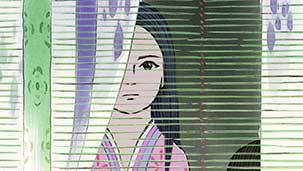It must be a thankless task to try and translate a work so thoroughly drenched in the folklore of a specific culture; because no matter how well you perform, something will be inevitably lost. There is no way to transmit the fundamental conceits that underpin the whole of the narrative. To do that would require a lifetime of work for both you and the audience. However, even if what you managed is a lesser work than the original, it still shines very brightly.
The Tale Of Princess Kaguya, an animated film from Studio Ghibli, is a beautiful, meandering film. Like much of traditional Japanese cinema, it is least troubled with pacing and plot. Tone and mood are the primary concerns here. The animation is loose and seemingly naturalistic, the score is haunting and subtle and the dialogue is minimal.
An inherently pastoral film The Tale of Princess Kaguya expresses a love of nature and a thoughtful examination of the cycles of birth and death. The sometimes misguided aspirations that parents force on their children is also one of the central themes, as well as a lot of gentle nudging about greed and social posturing and the often ridiculous pomp that props up rigidly defined class systems.
The choices that director Isao Takahata makes (he also directed Grave of the Fireflies, one of the most appallingly effective anti-war films I have ever seen) to tell a story so filled with myth and the supernatural are at the heart of its effectiveness. Compared to almost any animated film these days The Tale Of Princess Kaguya is noteworthy for it’s complete lack of visual pyrotechnics. This is a simple story told simply. The magic is in how that becomes so affecting.
The whole film is less a fable and more a series of metaphoric observations about some pretty universal concerns. What is truly valuable in life? Is it possible to be yourself as a young person and not disappoint your parents? Mostly though there is no lesson other than we are all variable creatures with many flaws and some strengths. Life is often filled with meaningless obligation and trivial strife so the moments of joy are inevitably tinged with melancholy.
If that seems trite it is only because I am failing in the translation. How the film evokes these sweeping, universal themes is earthy and quiet and utterly lacking in pretension. There is both a quiet joy and a pervasive sadness that every frame of this film somehow transmits. Part of this comes from the animation. The figures are simple and expressive and move with grace and elegance (except when they shouldn’t). The background art is exquisite, seamlessly reinforcing or contrasting whatever is happening in the foreground without drawing attention to itself. That it seems hand drawn is not just a stubborn adherence to tradition but a calculated, aesthetic choice that underlines the rustic slant of the whole project.
The Tale Of Princess Kaguya is an art house film in the best sense of the word. It requires engagement on the part of the audience and the capacity to let go of your preconceptions about what a story is and how it can be told, but it rewards those efforts with a film that was truly beautiful and moving. Long-winded and meandering in a very Japanese way, the payoff is nonetheless extraordinary.
Despite what must be countless moments that simply don’t line up with my Western sensibilities and background this film and your translation of it connected with something fundamental in me. Studio Ghibli is perhaps the single most able advocate of a kind of honest reverence for the natural world that I can think of, and you captured that reverence beautifully.
Sincerely,

Tim







